Wombat
| Wombats[1] Temporal range: Pleistocene to Recent |
|
|---|---|
 |
|
| Common Wombat, Maria Island, Tasmania | |
| Scientific classification | |
| Kingdom: | Animalia |
| Phylum: | Chordata |
| Class: | Mammalia |
| Infraclass: | Marsupialia |
| Order: | Diprotodontia |
| Suborder: | Vombatiformes |
| Family: | Vombatidae Burnett, 1829 |
| Genera and Species | |
Wombats are short-legged, muscular quadrupedal marsupials, native to Australia, approximately 1 metre (40 in) in length with a short, stubby tail. They are adaptable in habitat tolerance, and are found in forested, mountainous, and heathland areas of south-eastern Australia, including Tasmania, as well as an isolated patch of about 300 hectares (740 acres) in Epping Forest National Park[2] in central Queensland.
Contents |
[edit] Characteristics
Wombats dig extensive burrow systems with rodent-like front teeth and powerful claws. One distinctive adaptation of wombats is their backwards pouch. The advantage of a backwards-facing pouch is that when digging, the wombat does not gather dirt in its pouch over its young. Although mainly crepuscular and nocturnal, wombats also venture out to feed on cool or overcast days. They are not commonly seen, but leave ample evidence of their passage, treating fences as minor inconveniences to be gone through or under, and leaving distinctive cubic faeces.
Wombats are herbivores; their diet consists mostly of grasses, sedges, herbs, bark and roots. Their incisor teeth somewhat resemble those of the placental rodents (rats, mice, etc.), being adapted for gnawing tough vegetation. Like many other herbivorous mammals, they have a large diastema between the incisors and the cheek teeth, which are relatively simple. The dental formula of wombats is 
Wombats' fur colour can vary from a sandy colour to brown, or from grey to black. All three known extant species of wombats average around a metre in length and weigh between 20 and 35 kg (44 and 77 lb).
Female wombats give birth to a single young in the spring, after a gestation period, which like all marsupials can vary, in the case of the wombat: 20–21 days.[3][4] They have a well-developed pouch, which the young leave after about 6–7 months. Wombats are weaned after 15 months, and are sexually mature at 18 months.[5]
[edit] Ecology and behaviour


Wombats have an extraordinarily slow metabolism, taking around 8 to 14 days to complete digestion, which aids their survival in arid conditions.[5] They generally move slowly.[citation needed] When threatened, however, they can reach up to 40 km/h (25 mph) and maintain that speed for up to 90 seconds.[6] Wombats defend home territories centred on their burrows, and they react aggressively to intruders. The common wombat occupies a range of up to 23 ha (57 acres), while the hairy-nosed species have much smaller ranges, of no more than 4 ha (10 acres).[5]
Dingos and Tasmanian Devils prey on wombats. The wombat's primary defence is its toughened rear hide with most of the posterior made of cartilage. This, combined with its lack of a meaningful tail, makes it difficult for any predator that follows the wombat into its tunnel to bite and injure its target. When attacked, wombats dive into a nearby tunnel, using their rump to block a pursuing attacker.[7] Wombats may allow an intruder to force its head over their back and then use their powerful legs to crush the skull of the predator against the roof of the tunnel, or drive it off with two-legged 'donkey' kicks.
Humans who accidentally find themselves in an affray with a wombat may find it best to scale a tree until the animal calms and leaves. Humans can receive puncture wounds from wombat claws as well as bites. Startled wombats can also charge humans and bowl them over,[8] with the attendant risks of broken bones from the fall. One naturalist, Harry Frauca, once received a bite 2 cm (0.8 in) deep into the flesh of his leg—through a rubber boot, trousers and thick woollen socks (Underhill, 1993). A UK newspaper, The Independent reported that on 6 April 2010 a 59-year-old man from rural Victoria state was mauled by a wombat (thought to have been angered by mange)[9] causing a number of cuts and bite marks requiring hospital treatment. He resorted to killing it with an axe.[10]
[edit] Species
There are three living species of wombat,[1] all of which reside only in Australia. They are protected under Australian law.[6]
- Common Wombat (Vombatus ursinus)
- Northern Hairy-nosed Wombat or Yaminon (Lasiorhinus krefftii)[11]
- Southern Hairy-nosed Wombat (Lasiorhinus latifrons)
[edit] Name
The name wombat comes from the now nearly extinct Darug language spoken by the Aboriginal Darug people who originally inhabited the Sydney area.[12] It was first recorded in January 1798 when John Price and James Wilson, a white man who had adopted Aboriginal ways, visited the area of what is now Bargo, New South Wales. Price wrote: "We saw several sorts of dung of different animals, one of which Wilson called a Whom-batt, which is an animal about 20 inches high, with short legs and a thick body with a large head, round ears, and very small eyes; is very fat, and has much the appearance of a badger."[13] Wombats were often called badgers by early settlers because of their size and habit. Because of this, localities such as Badger Creek, Victoria and Badger Corner, Tasmania were named after the wombat.[14] The spelling went through many variants over the years including "wambat", "whombat", "womat", "wombach" and "womback", possibly reflecting dialectal differences in the Darug language.[12]
[edit] Conservation
The northern hairy-nosed wombat is an endangered species.[15] The biggest threats the species faces are its small population size, predation by wild dogs, competition for food because of overgrazing by cattle and sheep, and disease. [15][16]
The only known wild populations of this species exist in two locations in Queensland, the Epping Forrest National Park, and a smaller colony being established by translocating wombats to the Richard Underwood Nature Refuge at Yarran Downs.[15] This second colony is being created through the Xstrata reintroduction project which is being funded by Xstrata, a Swiss global mining company.[14]
The wombat population in the Epping Forrest National Park has been increasing since a predator-proof fence was erected in the park.[15] According to the latest census, taken in 2007, the park is home to 138 of these endangered wombats.[15]
[edit] Wombat Day
Since 2005 there has been an unofficial holiday called Wombat Day observed on 22 October, at the beginning of the traditional aboriginal spring planting season.[17]
[edit] References
[edit] Notes
- ^ a b Groves, C. (2005). Wilson, D. E.; Reeder, D. M. eds. Mammal Species of the World (3rd ed.). Baltimore: Johns Hopkins University Press. pp. 43–44. OCLC 62265494. ISBN 0-801-88221-4. http://www.bucknell.edu/msw3.
- ^ "Northern Hairy-nosed Wombat". Department of Sustainability, Environment, Water, Population and Communities. Australian Government. http://www.environment.gov.au/biodiversity/threatened/publications/northern-hairynosed.html. Retrieved 2 July 2011.
- ^ Watson, A (1999). "Vombatus ursinus". Animal Diversity Web. University of Michigan Museum of Zoology. http://animaldiversity.ummz.umich.edu/site/accounts/information/Vombatus_ursinus.html. Retrieved 13 August 2010.
- ^ Green, E; Myers, P (2006). "Lasiorhinus latifrons". Animal Diversity Web. University of Michigan Museum of Zoology. http://animaldiversity.ummz.umich.edu/site/accounts/information/Lasiorhinus_latifrons.html. Retrieved 13 August 2010.
- ^ a b c McIlroy, John (1984). Macdonald, D.. ed. The Encyclopedia of Mammals. New York: Facts on File. pp. 876–877. ISBN 0-87196-871-1
- ^ a b Humble, Gary (1 June 2006). "The Uncommon Wombat". Scribbly Gum. Australian Broadcasting Corporation. http://www.abc.net.au/science/scribblygum/june2006/. Retrieved 13 August 2010.
- ^ "Common Wombat". Department of Primary Industries, Parks, Water and Environment. Tasmanian Government. http://www.dpiw.tas.gov.au/inter.nsf/webpages/bhan-53f7kj?open. Retrieved 13 August 2010.
- ^ Robinson, Georgina (7 April 2010). "Wombat combat: danger is their middle name". The Examiner. http://www.examiner.com.au/news/local/news/general/wombat-combat-danger-is-their-middle-name/1796899.aspx. Retrieved 13 August 2010.
- ^ BBC News (6 April 2010). "Wombat bites Australian bush fire survivor". BBC News Online. http://news.bbc.co.uk/1/hi/world/asia-pacific/8604360.stm. Retrieved 9 April 2010.
- ^ The Independent (7 April 2010). "Australian Man Mauled in Rare Attack". The Independent. http://www.independent.co.uk/news/world/australasia/australian-man-mauled-in-rare-attack-by-wombat-1937850.html. Retrieved 7 April 2010.
- ^ "Lasiorhinus krefftii — Northern Hairy-nosed Wombat, Yaminon". Department of the Environment, Water, Heritage and the Arts. Australian Government. 12 February 2010. http://www.environment.gov.au/cgi-bin/sprat/public/publicspecies.pl?taxon_id=198. Retrieved 13 August 2010.
- ^ a b Butler, Susan (2009). The Dinkum Dictionary: The Origins of Australian Words. Text Publishing. p. 266. ISBN 1-921799-10-2.
- ^ Reed, Alexander Wyclif (1969). Place-names of New South Wales, their origins and meanings. Reed. p. 152.
- ^ a b "Common Wombat". Lady Wild Life. http://ladywildlife.com/animals/commonwombat.html. Retrieved 1 September 2008.
- ^ a b c d e "Northern Hairy-nosed Wombat". Queensland Government. 2011-10-13. http://www.derm.qld.gov.au/wildlife-ecosystems/wildlife/threatened_plants_and_animals/endangered/northern_hairynosed_wombat/. Retrieved 2012-02-08.
- ^ Willis, Paul (2003-03-07). "Northern Hairy Nosed Wombat". ABC Television, Catalyst. http://www.abc.net.au/catalyst/stories/s894095.htm. Retrieved 2012-02-08.
- ^ Middleton, Amy (22 October 2009). "The day of the wombat". Australian Geographic. http://www.australiangeographic.com.au/society/happy-wombat-day.htm. Retrieved 13 August 2010.
[edit] Further reading
- Wombats, Barbara Triggs, Houghton Mifflin Australia Pty, 1990, ISBN 0-86770-114-5. Facts and photographs of wombats for children.
- The Wombat: Common Wombats in Australia, Barbara Triggs, University of New South Wales Press, 1996, ISBN 0-86840-263-X.
- The Secret Life of Wombats, James Woodford, Text Publishing, 2002, ISBN 1-877008-43-5.
- How to Attract the Wombat, Will Cuppy with illustrations by Ed Nofziger, David R. Godiine, 2002, ISBN 1-56792-156-6 (Originally published 1949, Rhinehart)
- The Secret World of Wombats, Jackie French with illustrations by Bruce Whatley, HarperCollins Publishers, 2005, ISBN 0-207-20031-9.
[edit] External links
| Wikimedia Commons has media related to: Vombatidae |
- South Australian Government Faunal Emblem (official website)
- Rossetti's Wombat: A Pre-Raphaelite Obsession in Victorian England
- Sydney Morning Herald: Man attacked by wombat
- Secret sex life of wombat

